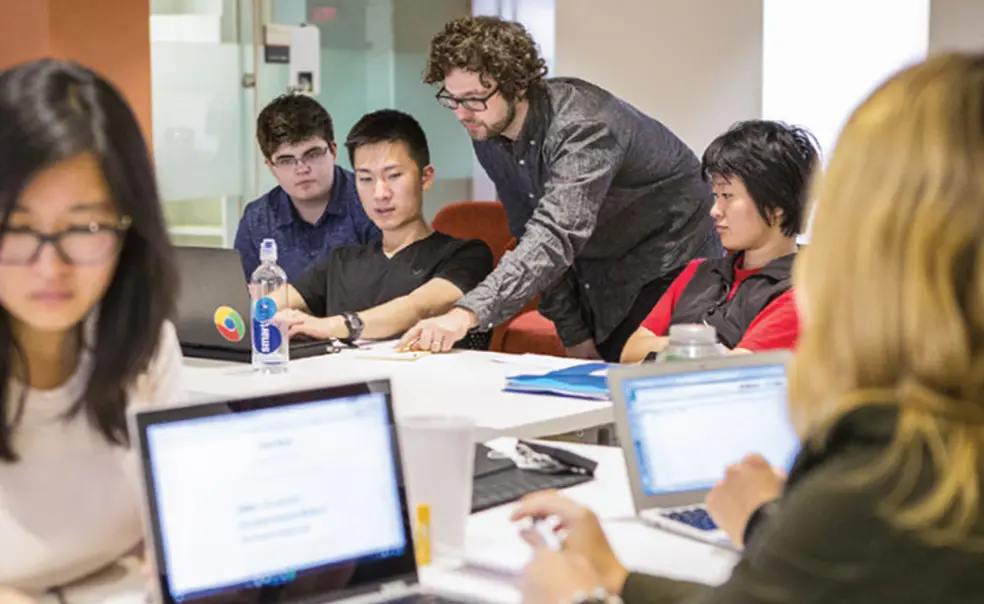Opening New Vistas for Scholarship: Digital Humanities at Princeton
There’s something new in the heart of Firestone Library. Take the elevator down to B Floor and step out. Where just a few years ago you’d find yourself in the middle of a long hallway, today you’re invited to look in, up, down, around, and through. Clear walls allow you to see one floor below into the Department of Rare Books and Special Collections. In front of you, encased in glass, is the new home of the Center for Digital Humanities.
The emphasis on light and open space in the center is not an accident. Nor is its location directly above Princeton’s Rare Books and Special Collections. As part of the University’s comprehensive renovation of Firestone, the center’s placement and design intentionally evokes the connection between past and future and heralds the development of a new kind of “laboratory for the humanities and social sciences.”
Building on the University’s original vision for Firestone, which emphasized open access to resources and study and meeting spaces that would bring faculty and students together, the Center for Digital Humanities (CDH) seeks to foster another kind of collaboration—by bringing advanced computational tools and humanistic scholarship together to forge new pathways to knowledge. In advancing its mission, the center supports key goals of the University’s strategic framework, which was approved by the University’s Board of Trustees last January. Specifically, the CDH enables Princeton both to exercise visible leadership in the humanities and to seize opportunities to use technology to expand the range of teaching and research.
Digital humanities scholarship is inherently collaborative. According to Jean Bauer, associate director of the center, “no digital humanities project can be done with one person’s expertise alone.” Every project requires multiple skills, disciplines, and areas of expertise, with the result that “everyone is working somewhat outside of their comfort zone.”
The center’s design—a comfortable, flexible meeting and teaching space with a whiteboard and media access, surrounded by glass-walled offices—is intended to create an inviting atmosphere in which this multidisciplinary collaboration can flourish. Its mandate to be “a hub for expertise in digital methods, tools, and best practices” underscores the center’s role as a matchmaker, if you will, bringing together scholars who wouldn’t normally interact to create new forms of knowledge.
The new center owes much to Meredith Martin, associate professor of English, who turned to the digital humanities while studying how English poetry was taught in the 19th and early 20th centuries. She discovered that prosody, the apparently fixed set of rules for reading poetry, was a subject of contentious debate often tied to issues of class and national identity. To discern trends in her sources, she needed to build a searchable database. Helped by librarians and computer scientists, she succeeded: the Princeton Prosody Archive now has more than 10,000 digitized records published between 1750 and 1923. It will be fully accessible to the public by the end of next year.
In the course of her work, Martin realized that Princeton could benefit from better coordination of its digital humanities efforts. She spearheaded the creation of a Digital Humanities Working Group that included University Librarian Karin Trainer, Princeton’s CIO Jay Dominick, staff from the McGraw Center for Teaching and Learning and the Council of the Humanities, and faculty from over 25 departments, including computer science. Together they developed a proposal for a Center for Digital Humanities at Princeton. I learned about the proposal as provost and was pleased to support it, and Martin’s role as faculty director, when I became president.
As the center enters its third year of funding and cuts the ribbon on its new space, Princeton’s venture in the digital humanities is emerging into full blossom. There is now a “digital humanities” track within the humanistic studies certificate program, with courses that include the well-subscribed “Introduction to Digital Humanities” and a junior seminar taught by Professor of Computer Science Brian Kernighan, who is serving as acting faculty director of the center this fall. CDH is also partnering with the Writing Center to introduce students to digital humanities research methods, with the hope of encouraging some digital humanities theses down the road. Projects by faculty and students are creating databases and online tools to mine insights from a host of fascinating sources, including Derrida’s marginal notes, Chinese exchange poetry, individual audio “letters” from the early 20th century, and rare children’s alphabet books, to name but a few.
In 1948, when Firestone Library first opened, Librarian Julian Boyd commented that the building’s architecture and technological features, however beautiful or fascinating, existed solely to house books and make them accessible “for the enlargement of the horizons of your mind.” The Center for Digital Humanities is fulfilling this original purpose in new and exciting ways.












No responses yet